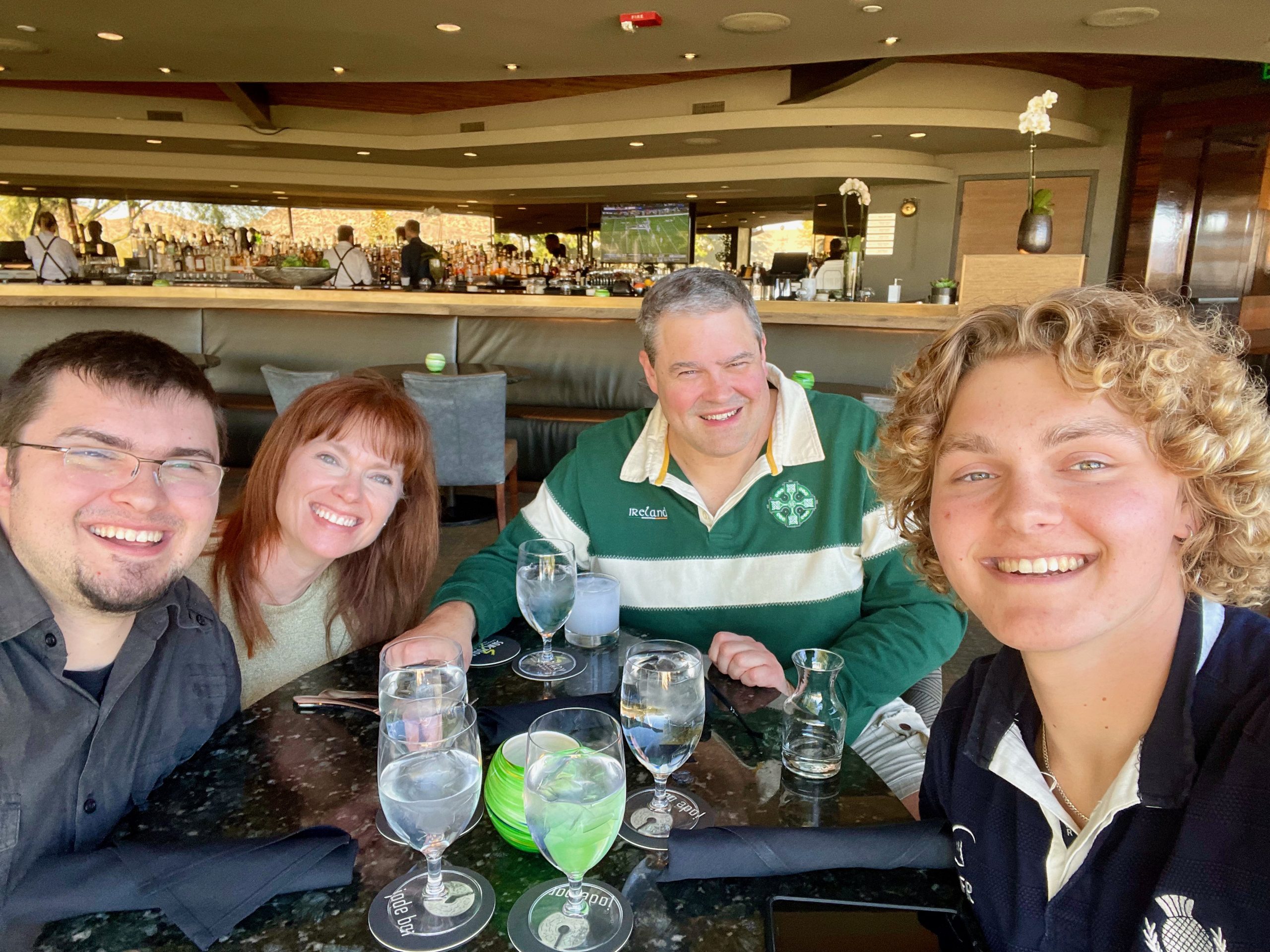November 1, 2023 — November is an important month to many transplant families across the country because it is National Marrow Donor Awareness Month, which is a time to acknowledge those who have donated bone marrow and stem cells to save other’s lives. November is also National Family Caregivers Month, which was established in 2014 to pay tribute to those caring for the health and wellbeing of family members, friends and neighbors. For the Kurth family of Scottsdale, Arizona, both of these month-long, awareness-raising celebrations have a significant impact on their now adult son’s transplant journey to date.
While many families’ transplant journeys begin at birth, that is not the case for the Kurths. Julie and Tracy had been blessed with two boys who they had greatly enjoyed raising from birth to adolescence and were excited to watch them both step into adulthood. Julie recalls that during the summer of 2018, their youngest son, Adam, had been invited to accompany two different friends on their family vacations. Lots of excitement surrounded these two adventures so Julie thought it was odd when Adam texted her on the first of the two trips letting her know he was extremely itchy. She remembers back to that summer, “He came home from the first trip and we had 24 hours to see a doctor at the urgent care clinic, pick up a prescription and get Adam packed and ready for the second trip.” Adam, age 17 at the time, enjoyed both of those summer adventures. But his enjoyment was definitely dampened by the incessant itching, which at times was becoming unbearable.
Adam stepped into his junior year of high school and the family decided it was time to see an allergist for his persistent itching. Blood tests were ordered but were inconclusive about allergies. Instead, they indicated very high liver enzymes — likely the cause of the persistent itching — but the allergist’s team did not know why. It was, however, an important stop on what would be a lengthy and unexpected medical journey for Adam. That October, he became quite jaundiced and was admitted to the hospital. A liver biopsy was ordered; it indicated his liver was damaged. At the time, the family thought Adam had likely used too much whey protein powder during a period of time when the teenager was singularly focused on exercise and eating to be more fit. They anticipated everything would likely be fine after removing the protein powder from his daily diet.
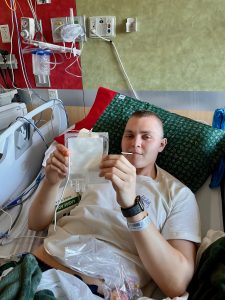
Two months later and still jaundiced, Adam was sent back to the hospital for further testing. This time the news was quite different and much more troubling. Adam was diagnosed with Primary Sclerosing Cholangitis (PSC), which is an autoimmune disease that impacts the liver bile ducts. PSC causes the ducts to scar, narrow and harden, which can eventually lead to liver failure. By January 2019, Adam was placed on the liver transplant waiting list at Phoenix Children’s Hospital and that summer, he was also listed at the Mayo Clinic Phoenix in the event a living liver donor was found. During this time, Adam underwent endoscopic retrograde cholangiopancreatographies every three to four months to replace stents that were keeping his bile ducts open. According to Julie, the aggressiveness of his PSC and the fact he was stent-dependent was unusual and seemed to point to bile duct cancer, although all tests were negative, which seemed to perplex the experts at both Phoenix Children’s and the Mayo Clinic Phoenix.
Julie describes the months of waiting for ‘the call’ as challenging for the family. During the beginning of 2020, Adam had two dry runs which meant he was admitted to Phoenix Children’s and prepped for the surgery only to learn the livers were not good quality — especially for an 18-year-old with many years of living ahead of him. During this time of waiting for the perfect liver, both transplant teams suspected cancer could be causing some of the ‘unknowns’ surrounding Adam’s diagnosis. More tests were run, but nothing was detected. What the family did know was that during the winter months of 2020, Adam’s condition worsened, and he was quite ill. Adam was hospitalized monthly for the first three months of 2020. When he received his third liver offer, Adam was in the beginning of the spring semester of his senior year of high school. According to Julie, “Despite an abundance of advice to the contrary, Adam turned it down because he wanted to wait until after his high school graduation and senior trip in May.”
Then COVID-19 struck the country. On March 20, 2020, all elective surgeries were delayed throughout Arizona by order of the governor. Because Adam had already been offered three deceased donor livers, Julie and Tracy had already had numerous meetings and phone calls with various members of the Phoenix Children’s transplant team preparing them for Adam’s journey. One of those conversations was with a transplant social worker who spoke to them about many transplant-related issues the family would be facing. She suggested they might want to reach out to the Children’s Organ Transplant Association (COTA) to learn more about what assistance and guidance COTA might be able to offer.
On March 27th, Julie placed a call to COTA to learn more and to explain Adam’s situation. The family had private health insurance, which meant they had already been dealing with co-pays, deductibles and insurance premiums. Since the family lived fairly close to the transplant center, assistance with mileage and lodging would not likely be needed. Julie did want to learn more about how COTA works for teens like Adam who would soon be transitioning into adulthood and then responsible for their own health care insurance and medical expenses. On April 1st, Julie and Tracy completed and sent their signed agreement to COTA’s Indiana headquarters, and the Kurth family officially became part of the COTA Family.
Also on April 1st, the family received another call that a viable liver was available. This time, with the anxiety of the COVID-19 shutdowns weighing on his decision, Adam decided to accept the offer and they were admitted to Phoenix Children’s Hospital on April Fool’s Day. He received his new liver at midnight on April 3rd; Julie says the transplant surgeon told them Adam’s new liver was one of the healthiest she had seen in some time.

The Children’s Organ Transplant Association (COTA) uniquely understands that parents who care for a child, teen or young adult before, during and after a life-saving transplant have enough to deal with; therefore, COTA’s model shifts the responsibility for fundraising to a team of trained volunteers. COTA is a 501(c)3 charity so all contributions to COTA are tax deductible to the fullest extent of the law, and COTA funds are available for a lifetime of transplant-related expenses.
On April 15, 2020, a COTA fundraising specialist trained the family’s group of volunteers via telephone due to COVID-19 and so fundraising for transplant-related expenses could begin immediately. The COTA staff member shared information about COTA’s fundraising process, fundraising templates, guidance and support, and the no-cost website they would be provided. COTA in honor of Adam K was launched, and the website was immediately available for online donations to help with transplant-related expenses.
On May 6, 2020, Julie blogged on the COTA-provided website: “Happy Birthday, Adam Kurth! We are ecstatic you made it to 19. We truly have a lot to be grateful for this year with Adam receiving a new liver on April 3rd. So, in honor of this ‘rebirthday’ and his 19th birthday, we are celebrating with 19 reasons to donate to the Children’s Organ Transplant Association in honor of Adam. COTA assists with transplant-related expenses through fundraising and family support.”

Julie’s blog post on the COTA for Adam K campaign website listed 19 reasons to donate that included #1 Today is Adam Kurth’s 19th birthday! Transplant surgeries cost about a million dollars, so now he is a million-dollar man!”
Adam’s old liver was sent to pathology for examination. The family learned Adam’s liver tested positive for diffuse large B-cell lymphoma. Adam’s hepatologist told them she could only find five documented medical cases like Adam’s that included a diagnosis of PSC and lymphoma. She also told the family that the surgeon said he had no idea how Adam’s liver was working at all. Even though Adam’s liver team felt they had removed all of the cancer when his old liver was removed, due to two suspicious lymph nodes, Adam had to undergo post-transplant chemotherapy as a precaution.

In May 2020, Adam graduated virtually from Desert Mountain High School in Scottsdale. Also that month, Adam began a series of four, weeklong Phoenix Children’s Hospital stays for chemotherapy treatments. At various times that summer, Julie kept their followers and supporters updated on Adam’s treatments with powerful messages on the COTA website:
“Adam is halfway through his chemotherapy. As expected, after two rounds, he has lost his blonde, wavy, collar-length hair. But hair is not everything. While Adam is at home, his father has relished the chance to round out Adam’s education, filling in gaps missed due to illness during high school. Adam wants to go on to study mathematics in college, so his dad is beefing up Adam’s math skills and his knowledge of many more subjects. In fact, they talk for hours every day.”
“Chemo is a tough haul, as many know firsthand. Each round is slightly different for Adam. The first was full of headaches and nausea with water tasting like cough syrup. The second ended in fatigue and this third round is affecting his appetite and he is riddled with underlying impatience. He is ready to be done.”
“With the simple ringing of a bell, Adam marked the end of his chemotherapy. He will not miss the nausea, nosebleeds, baldness or hospital stays. Thanks to the support from friends and family, Adam has made it through. The only sign of Adam’s lymphoma was in the liver that was removed in April and a nearby lymph node. Had they known before transplant Adam had cancer outside the organ to be removed, he would have been declared not a good candidate for a new liver for the rest of his life.”
While undergoing chemotherapy, Adam completed a year of college online through Scottsdale Community College so he could stay on track with his academic and career dreams. It was not easy, but he did it, which was emblematic of how he approached his ongoing transplant journey.
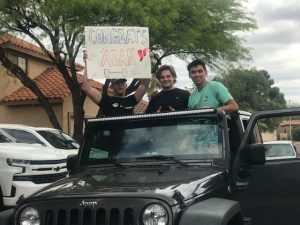
In May 2021, the COTA in honor of Adam K team of volunteers organized and hosted an incredibly successful golf outing that got the team closer to the $100,000 fundraising goal. Julie and Tracy were extremely grateful for their community’s support of their family and of COTA. At the end of that summer, Adam started attending Arizona State University majoring in mathematics and statistics.
“Before Adam’s liver transplant, we were coping with multiple hospital stays and the stress of not knowing when we would get ‘the call’ letting us know a suitable liver had been found,” Julie said. “During this time of unrest and unknown, the head of COTA, Rick Lofgren, called to personally speak with me. He explained how COTA could help and asked if our family had any questions. I will never forget that call.” She continued, “COTA did not just help our family, they helped our volunteer team with fundraising ideas, suggestions and support so our friends’ and family members’ efforts could be successful. COTA encouraged our volunteers not to get discouraged or to give up … even in the midst of a pandemic.”
Adam’s entire family were his close circle of caregivers, but Mom Julie quickly became his primary caregiver when the onset of COVID-19 restricted who could be inpatient with him. As one chapter of Adam’s transplant journey closed and while they were waiting for the next, Julie looked back and wrote observations about how far they had come as a way to share her gratitude with their COTA volunteers and prepare for what would be coming next in Adam’s journey.
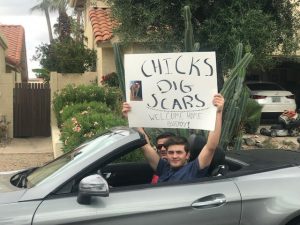
Right about the time Adam had his transplant in early April, Phoenix Children’s Hospital started to reduce the number of visitors to one parent at a time per patient. Dad would visit whenever he was able, and Adam’s brother David and friends would FaceTime him. This largely meant that for many days and weeks, I was the only person from home Adam saw. The hospital had cancelled all elective procedures due to the pandemic. ICU was hauntingly quiet. In fact, for at least one or two of the days Adam was in ICU, he was the only patient in the ward. When he graduated to a regular hospital bed, I was the first parent to arrive. The nurses were unsure if I should be tested for coronavirus or not. All the rules the staff had to follow had changed seemingly overnight.
Although I did spend a few initial nights at the hospital, once Adam was out of ICU, I trekked home to my own bed each night. My mornings consisted of two key routines on the 25-mile commute to Phoenix Children’s. First, I would dial in to a daily Arizona State University COVID clinical lab team call at 8 a.m. The ASU research institute where I work was then beginning to offer clinical testing for COVID-19, so my work was intense. While on my morning calls, I would pick up coffee.
Waving at our favorite security guard, I would proceed to the hospital room, rolling my laptop bag behind me. The room was usually dark upon my arrival, with Adam sleeping in after a night of interruptions for vitals, medications, and labs. I would work by his bedside, watching for the liver team to do its rounds. Once he awoke, he greedily reached for his cold brew I had picked up on my drive, pulled opened the blinds — letting sunlight stream into his room, and told me about his night. During my 12-hour days at the hospital, I periodically moved to the family lounge to join virtual work meetings. Other times, I would be beside Adam, as the revolving door of hospital workers came and went. The cast of characters included therapy dogs, coffee cart, case manager, pediatric floor attending, hepatologist on duty, liver coordinator, medical tech, nurses and more. We were glad to see them, in fact, they seemed like friends.
When Adam was first diagnosed with PSC, I had stopped at Safeway to buy milk on my way home from work. In my parked car, I read about his liver disease on my phone. I had not felt brave enough to do this until then. I learned that patients with PSC had a 10-15% higher than normal chance of cancer of the bile ducts. Over the lifetime of these PSC patients, 20% are diagnosed with cholangiocarcinoma. And only 15% of patients with bile duct cancer caught in early stages lived 5 years. I have to admit, this was one of the times I cried. Little did I know then all that was to come.
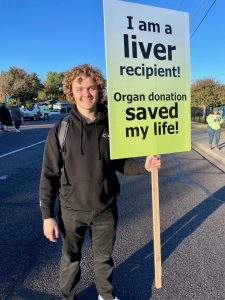
In May 2021, Adam was cancer-free at his nine-month checkup. It was a cause for celebration; Adam was given the ‘all clear’ for another three months. Checkups like this continued throughout 2021, but in December Adam’s comprehensive immunohematology clinic at Phoenix Children’s consulted with him about having a bone marrow transplant. This decision was prompted due to the unusual comorbidity of his PSC diagnosis and the large B-cell lymphoma in his native liver. The underlying cause of both his PSC and cancer was common variable immune deficiency. A bone marrow transplant would cure Adam’s immune condition and reduce his now high risk of recurrence of cancers or other autoimmune diseases. Adam’s journey now included a second transplant; he was determined to take this next step to a cancer-free and autoimmune-free future.
Adam endured an intense round of chemotherapy to eliminate his own immune system and then received a bone marrow transplant. Adam’s bone marrow transplant process started by looking for a donor in August 2022 and was completed with an infusion of donor cells on December 21, 2022. This second transplant is allowing Adam to live a fairly normal life, but one that will still be filled with medical appointments and pharmaceuticals.
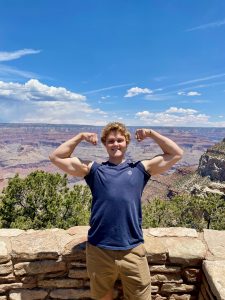
Again, with Adam’s second transplant, COTA has given the Kurths a big dose of reassurance and calm. “COTA’s support and guidance has eased transplant-related stressors on our family budget,” Julie said. “We are very fortunate to have good health insurance, but the onslaught of copays for a multitude of doctors’ visits, tests, surgeries, dozens of prescription medications each month, and two life-saving transplants would have financially crippled us. Adam must take immune suppressing drugs for the rest of his life to avoid rejection. We are beyond grateful that COTA funds will be a safety net to assist with transplant-related expenses for a lifetime.”
Adam authored an article for the Phoenix Children’s Hospital after his liver transplant. Here is an excerpt that is brimming with hope and gratitude, which are appropriate messages with Thanksgiving coming later this month:
I will never stop learning. I am interested in a career in statistics and advanced mathematics. I have an interest in automotive design and hope to one day solve engineering puzzles. My ideal future consists of good health for me, my friends and my family. No matter what happens, I plan to strive to be as happy as I can. I was shown, firsthand, how fast health and happiness can be taken away. Today, I celebrate the little things, like a nice cup of coffee, a deep conversation, a complicated problem to solve, a relaxing drive, exhilarating music and a thoughtful walk. My health situation has taught me all I need to know about how to cope with whatever comes.
Happy Thanksgiving, Kurth Family, from your COTA Family!
National Marrow Awareness Month is observed each November. During this time, the accomplishments of physicians who perform transplant research are celebrated. Bone marrow and stem cell donors are remembered with gratitude for saving lives nationwide. Each year in the United States, more than 17,000 people are diagnosed with life-threatening illnesses that require a bone marrow, stem cell or cord blood transplant, which replace diseased cells with healthy cells. The more people who donate marrow; more people will survive. Please consider becoming a marrow donor. Go to BetheMatch.org to learn more about registering to become a bone marrow, stem cell or cord blood donor.
When establishing November as National Family Caregivers Month, President Obama said, “Each day, courageous individuals step forward to care for family members in need. Their quiet acts of selflessness and sacrifice tell the story of love and devotion.”
